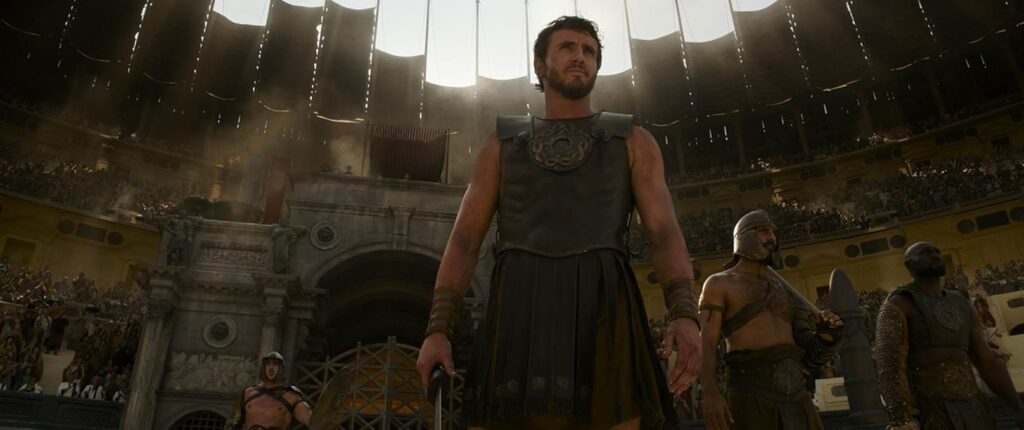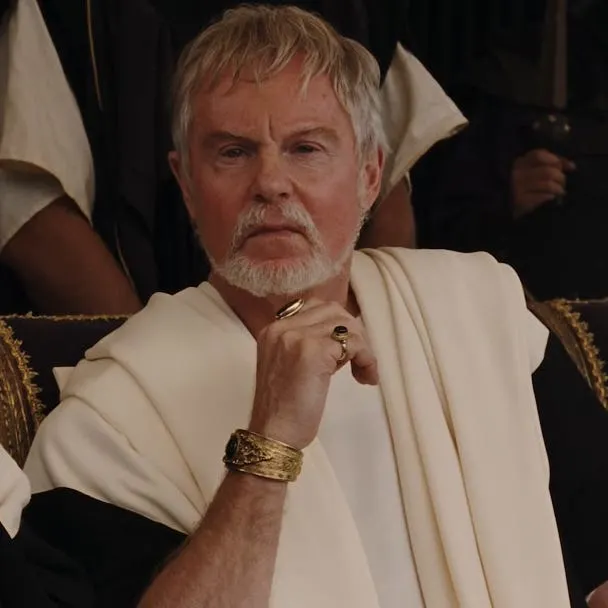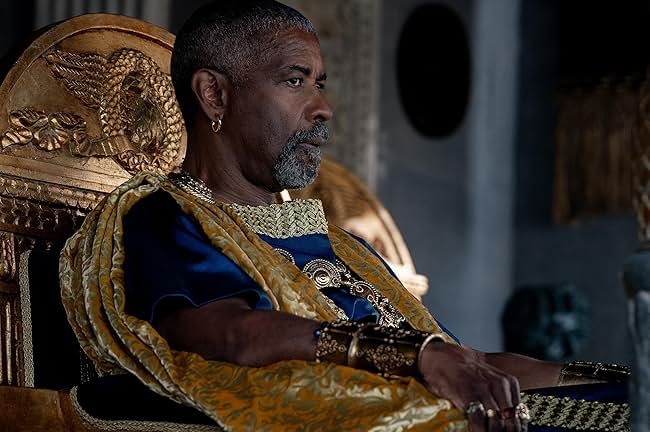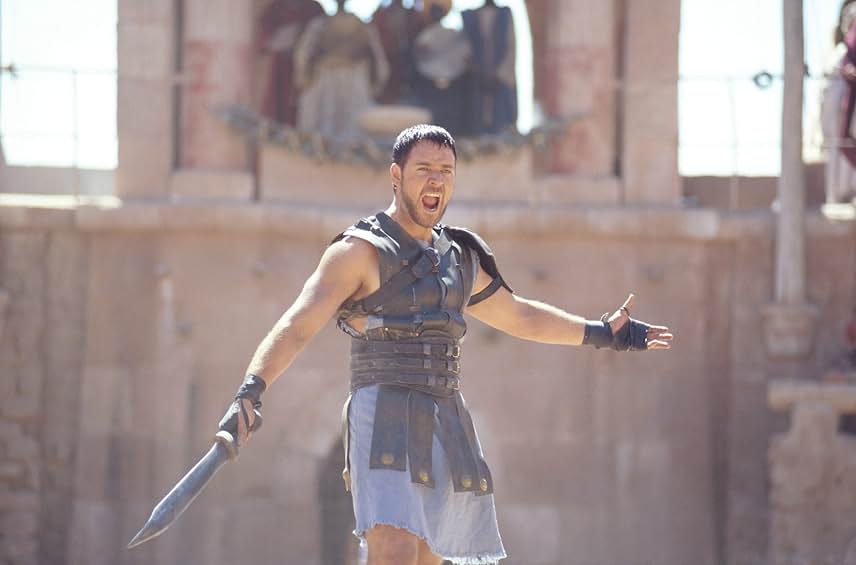I never want to see this movie again. Granted, this might sound a bit harsh coming from a Classics undergrad who spent most of his Classics Club movie nights rewatching the first installation of this movie franchise—yet I remain steadfast: I never want to see this movie again.

I have no issue with some of the creative liberties and historical inaccuracies adopted by Ridley Scott that people too often bemoan in movies like this (such as a newspaper being read in a café or sharks in the Colosseum). All those complaints don’t significantly diminish the art of the film. The medium of film allows for a greater exploration of entertainment and artistic journey than, say, Edward Gibbon’s Decline and Fall of the Roman Empire might. The director must have room to explore and create the experience he thinks will encourage the audience to participate in his vision. I agree wholeheartedly with Ridley Scott’s “get a life” remark to all the historians, such as my former Latin professor, Shadi Bartsch Zimmer, who bombarded the review pages of Gladiator II with lists of trifling historical inaccuracies.
But much more than historical inaccuracy set this movie apart from its Oscar-level predecessor. Like its 2000 forerunner, this installment brought on a host of supremely talented actors (Paul Mescal, Pedro Pascal, Denzel Washington) to create a hit Hollywood blockbuster. Yet even with new blood, novelty in the script and characters did not shine through enough. The return of Connie Nielsen and Derek Jacobi maintained a sense of continuity for the audience, with both delivering strong performances on par with the first Gladiator, but that is just it: these individual performances did not overcome flat character development and a trite storyline when compared to the original epic.

Shadows of the first movie loom over this strikingly similar plotline of a man turned slave, turned gladiator, turned champion, focusing on Lucius’ (Paul Mescal) anger as his driving force to seek “vengeance in this life or the next.” However, while Maximus of the original Gladiator accomplishes his vengeance in a dramatic ending, Lucius’ anger towards his mother and Rome fades away rather ambiguously. As often happens in modern remakes, the sequel echoes the thrill of nostalgia, yet cannot live up to the creative magnitude of the original.
This is not to say that there aren’t good artistic parts of this movie. The casting for the film remained almost as stellar as the first. The performances of Joseph Quinn and Fred Hechinger, twin emperors Geta and Caracalla respectively, portrayed the most vile mixture of absolute hedonism and sinister character, showcasing their obvious talent amidst a rocky script and storyline. It was also fun to see Paul Mescal, known for indie films such as Aftersun and All of Us Strangers, finally cut his teeth on a much larger lead role in a Hollywood blockbuster, taking up the top-billing mantle from Russell Crowe. The hype and excitement to see Denzel Washington was palpable in reviews leading up to the film. The man, etched in Hollywood fame, with strong performances as boxer Rubin Carter in The Hurricane or the heartrending role of Troy in August Wilson’s play-turned-movie Fences, stepped into the gladiatorial arena of film to prove once again his mastery of the craft. Yet, his performance as the violent slave-trader Macrinus was a microcosm of the lack of originality from which the whole plot suffered. His mannerisms and tone remind the audience of a previous character from his Oscar-winning performance as Alonzo Harris in Training Day. Macrinus and LAPD narcotics officer Alonzo have the same snappy and brutal attitude, focusing on personal prestige and power. It’s just a costume change. In the scene before the Senate, as the city falls to pieces around them, Macrinus delivers the line, “I need power.” Denzel’s intonations and movement of his body and head powerfully recall the famous “King Kong” speech from the end of Training Day. The audience was left wanting for Denzel’s immense experience and versatility while portraying Macrinus.

This brings me to the real gripe I have with this movie, and why I will never watch it again: it was unmistakably too brutal for me. It felt like every three minutes, Ridley Scott looked for a way to offend the viewer with blood and gore that seemed more appropriate for a Saw film. True, brutality is unavoidable in a movie about Roman gladiators, some of the most violent characters in human history. But I felt that Scott did this in a much more restrained way in the first movie that did not cause me to tense up, as I did during multiple scenes of the sequel. As I left the theater, I recalled Seneca, who attended the gladiatorial games 2000 years earlier, and how he too was “expecting something of relaxation… but it was pure murder” (Seneca, Epistle 7.3). Why such a stark portrayal in the first place? This may be Scott’s attempt at originality within the sequel. But it also relates to the artistic relationship between the director and the audience.
In any good movie, I believe that the expression of the film not only hinges upon the cinematic vision of the director, but primarily on what the director deems an audience will enjoy. The violence in the film isn’t merely unfounded gore and blood for violence’s sake; something much deeper is happening. Scott, like the orchestrators of the gladiator games in Rome, puts on a display to sate public interest in his movie with dazzling moments of violence and blood. And we, much like St. Augustine’s friend and student Alypius, struggle to remove our eyes from the grisly spectacle. Instead, we find ourselves “drinking in madness unconsciously, delighted with the guilty contest” (Augustine, Confessions VI.8.13). In our ignorance of what it was to be a fighter within that sand arena, we escape to the theater to experience this historical horror at a distance. With our participation, we reaffirm Scott in his cinematic decision to depict violence in this excess. Why are there sharks or man-eating baboons in the movie? Because that is what captivates his audience so enthralled by the idea of the gladiator. Even though Scott draws in his viewers by constructing elaborate scenes of blood and gore where glory is only won by surviving the most grisly and visually disturbing odds, still, the medium of film allows the audience to realize how gross and unsettling the reality is. We too, like patrons of the games, can look away in horror at the sight of the grim reality.
With these points in mind, I think it is good for the audience now to consider the art of film more deeply. We are not merely passive viewers of the spectacle put together by the director, but rather active informers of artistic decisions. Like any art, there is a dynamic element of influence in cinema that roots itself in the spectators’ verbal or nonverbal communication with the director. The audience is at its discretion whether to continue viewing and thus participating in the ancient practice of gladiators seen in Scott’s movie.

Are we entertained? Yes, but personally, within the pantheon of great classically-inspired movies, I would gladly put this one to the side in favor of the beloved 2000 original.

